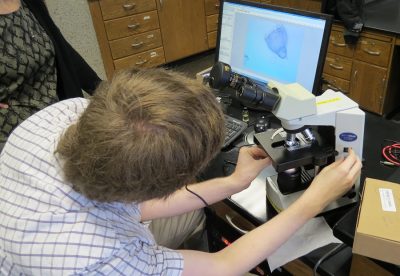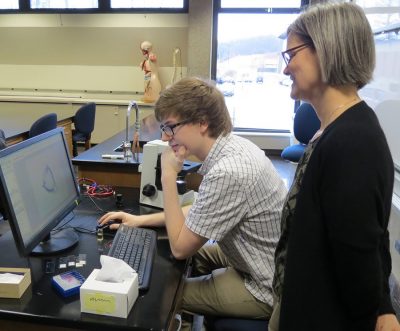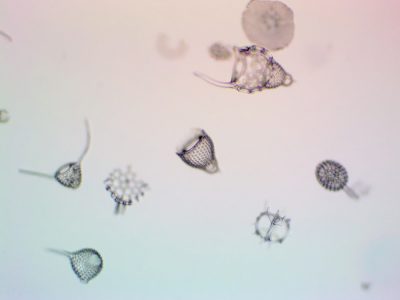
One of the interactive elements of CMoG’s exhibition Revealing
the Invisible: The History of Glass and the Microscope allows
visitors to be microscopic.
If you’ve visited the Rakow Research Library recently, you may have seen one of our new exhibitions, Revealing the Invisible: The History of Glass and the Microscope, and experienced the Be Microscopic interactive that “shrinks” visitors down to the size of a cell.
The Museum’s Digital Media team created this immersive interactive experience using a Microsoft Kinect camera for Windows, technology with which many video-gamers may be familiar. The camera captures live video and tracks users’ spatial positions, body movements, and gestures. The project called for a complex combination of interactions, “green-screen” effects, and other display needs, so it required some trial and error to determine the best way to create the program. The team settled on using a software library for Kinect called Vitruvius. This C#-based library provides methods that make it easier to access the camera’s body tracking data, and to use that data to trigger on-screen actions like changing specimen images and taking snapshots of visitors in this microscopic world.
- The background images of microscopic specimens were captured by Nick Jividen, a recent graduate of Corning Community College. Nick used a microscope outfitted with a digital camera to photograph various specimens.
- Brenda Gustin, professor of biology at Corning Community College, allowed Nick to use her laboratory and equipment for this project.
Since the exhibition space was in use for our recent Pyrex exhibition, the team set up a prototype in a storage/staging room next to the contemporary galleries. That allowed the team to see the work in progress, test the programming, and figure out how the camera and other equipment would need to be set up.
- Radiolaria at 100x magnification. These microorganisms have skeletons made of silica, the main ingredient in glass.
- Prototyping the interactive, with Kinect camera on a tripod for ease of adjustment.
One of the big challenges was ensuring visitors understood what to do to interact with the program. Luckily, part of the fun is in experimentation! Swiping your arm or waving at the wall all trigger an action on the large projection.
You can see the results from pictures that visitors have shared on Instagram, Facebook, or Twitter by searching the hashtag #CELLFIE.
Revealing the Invisible: The History of Glass and the Microscope is open 9am – 5pm every day through March 19, 2017. This exhibition tells the stories of scientists’ and artists’ exploration of the microscopic world between the 1600s and the late 1800s. Unleash your sense of discovery as you explore the invisible through historic microscopes, rare books, and period illustrations, and take a #cellfie in the Be Microscopic interactive.





